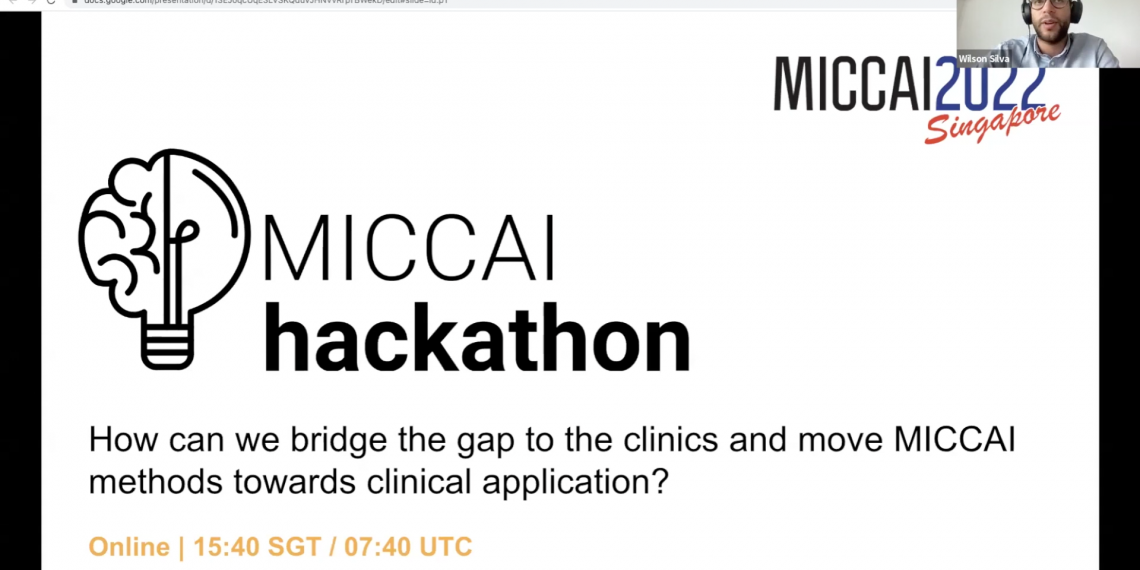INESC TEC researchers in the field of Visual Computing & Machine Intelligence (VCMI) have been developing work in different sub-areas of research, in the field of medical imaging and computer-assisted diagnosis, with several publications on computational pathology, interpretability in artificial intelligence, detection of pathologies in medical images and extraction of radiogenomics elements.
In order to disseminate the work developed at the Centre for Telecommunications and Multimedia (CTM), leading this specific area of research, the Centre’s coordinators focus on the participation in events and consequent submission of papers, and the organisation/co-organisation of satellite events.
An example was the participation of CTM researchers, namely Helena Montenegro, Isabel Rio-Torto, Jaime S. Cardoso, Tiago Gonçalves and Wilson Silva, in the International Conference on Medical Image Computing and Computer Assisted Intervention (MICCAI 2022), which took place between October 18 and 22, in Singapore.
MICCAI, the top international conference in the field of medical imaging, aims to bring together the world’s leading biomedicine researchers and professionals, engineers, and clinicians from a wide range of subjects associated with medical imaging and computer-assisted intervention, ensuring an exchange between academia and industry.
Helena Montenegro, Wilson Silva and Jaime S. Cardoso presented the paper “Disentangled Representation Learning for Privacy-Preserving Case-Based Explanations” at the “Workshop on Medical Applications with Disentanglements”. This work proposes a new method to extract medical elements and characteristics related to the identity of patients from medical images, allowing them to be manipulated for the purpose of anonymisation and generation of counterfactual explanations.
INESC TEC was responsible for the organisation of the workshop “Interpretability of Machine Intelligence in Medical Image Computing” (iMIMIC), which took place on September 22. The workshop featured two main presentations – one by Ruth Fong (Princeton University, U.S.A.) and the other by Alexander Binder (University of Oslo, Norway) – and the presentation of 10 selected scientific papers; the workshop focused on discussing the interpretability of clinical computer learning systems, identifying opportunities and challenges.
INESC TEC was also responsible for organising a competition that challenged teams to solve real-world problems, proposed by a diverse group of mentors, which took place between September 3 and 4. With the motto “Bridging the gap to the clinics”, this hackathon promoted the discussion on ideas to connect technologies generated via scientific papers and the clinical community, providing conditions for the practical applicability of the methods. The best teams had the opportunity to present the results of their work on September 18, at a time that also featured two keynote speakers: Po-Hsuan Cameron Chen (Google Health, U.S.A.) and Wiro Niessen (Biomedical Imaging Group Rotterdam at Erasmus MC, The Netherlands). The winner of this year’s edition was Amith Kamath, currently attending a Phd programme at the University of Bern (Switzerland), who addressed the task “Task 1 – Domain Shifts Between Clinical Annotators”; Amith was mentored by Mara Graziani (IBM Research, ZHAW and HES-SO Valais-Wallis) and Henning Müller (HES-SO Valais-Wallis).
The hackathon videos are available here: https://www.youtube.com/@miccaihackathon643
The INESC TEC researchers mentioned in this news piece are associated with INESC TEC and UP-FEUP.




 News, current topics, curiosities and so much more about INESC TEC and its community!
News, current topics, curiosities and so much more about INESC TEC and its community!